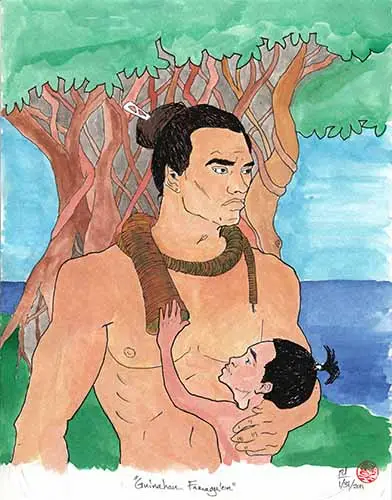Guinahan Famagu'on: Children's Wealth

Type of traditional turtle shell valuable
Commonly translated as “children’s wealth,” guinahan famagu’on refers to a type of traditional turtle shell valuable, or ålas, used in the highly reciprocal lifestyle of ancient CHamorus/Chamorros. Though it was worn as a necklace, it was not like other turtle shell valuables in that it was also worn by men. Guinahan famagu’on was the most highly esteemed of the different forms of ålas.
French explorer Louis Claude de Freycinet visited the Marianas and wrote about the valuable body ornament:
Normally, its shape approached that of a truncated cone, extremely elongated. It was, in general, approximately six inches in diameter at the broader end, one inch at the other. This was an ornament of great state and within reach of only the wealthy. It was worn round the neck, with the two ends hanging unequally over the stomach.
Guinahan famagu’on was the social payment due to anyone who had saved the life of a child, paid by the parents. If the saved child’s parents could not afford to pay with this, the wider, extended family would come to their aid out of a sense of shared social duty and familial pride. The savior could then either choose to accept this as a gift or refuse it, thereby becoming part of that family as a sort of in-law. This ceremony bespeaks the intricate, interdependent nature of ancient CHamoru society.
For further reading
Cunningham, Lawrence J. Ancient Chamorro Society. Honolulu: Bess Press, 1992.
Freycinet, Louis Claude Desaulses de. An Account of the Corvette L’Uraine’s Sojourn at the Mariana Islands, 1819. Translated by Glynn Barratt. Saipan: Commonwealth of the Northern Mariana Islands Division of Historic Preservation, 2003.
Russell, Scott. Tiempon I Manmofo’na: Ancient Chamorro Culture and History of the Northern Mariana Islands. Saipan: Commonwealth of the Northern Mariana Islands Division of Historic Preservation, 1998.
